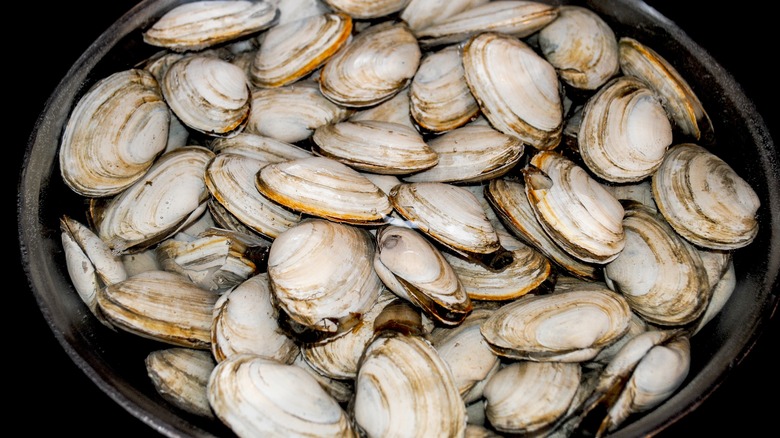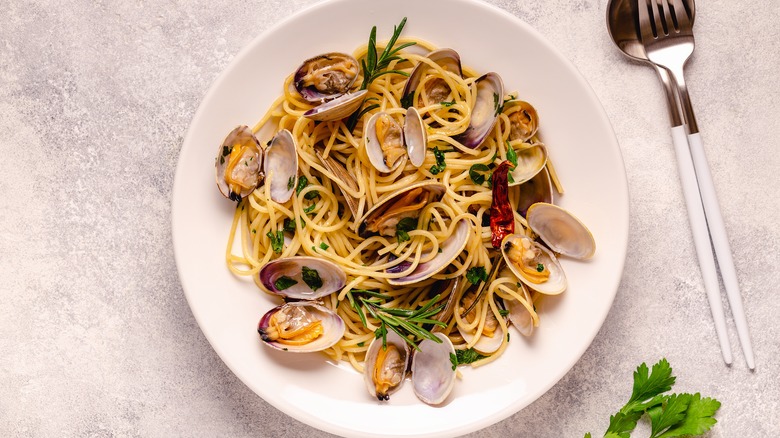Martha Stewart's Must-Know Tip For Picking Clams
No shellfish may be as challenging to master as the clam. Whether you're learning how to make creamy vongole e polenta or figuring out whether to use fresh or canned clams, these small shellfish require a lot of care to truly shine. With so many varieties available for sale, it can be quite overwhelming for beginner cooks to shop for this mollusk. Fortunately, renowned food writer and TV chef Martha Stewart has advice on selecting clams at the store, recommending a close, thorough examination of their shells.
@marthastewart Preparing clams at home might be intimidating, but it's easier than you think. New episodes of Martha Cooks only on @therokuchannel #marthacooks #cookingtips #recipes
Stewart recommends purchasing live clams whose shells are tightly shut. When steamed, these shells will gradually open, revealing their delicious meat hidden underneath. Fresh, live clams should always have fully closed shells at the time of purchase, or they should close promptly when touched. Clams that are unable to seal are most likely dead—and maybe even beginning to decompose. Thus, they are more likely to carry foodborne pathogens that could make you sick. If you notice a few opened ones in your batch, simply discard them. The only exception to this rule is soft-shelled clams, as they have a longer siphon that makes them physically unable to fully close their shells.
Soak your clams in water before steaming them
Clams are filter feeders, meaning they eat by filtering out tiny microorganisms from the sea. This process causes them to ingest sand and other inedible debris over time, as they must open their shells and draw in water to sustain themselves. If left uncleaned, this allows grit to enter your food as your clams open during cooking, inevitably ruining the flavors and textures of your dish. To avoid this issue, you'll need to learn how to purge clams, and Martha Stewart has a few more tips on this as well.
For cleaning the insides of clams, Stewart recommends letting these mollusks soak in cold water for 30 minutes or longer. This duration gives the mollusks enough time to open up, restart the filtering process, and expel any sand lodged in their insides. Using cool water will prevent your clams from experiencing temperature shock, which could cause them to open and die. If your shellfish came from an ocean or another salty body of water, you'll also want to salt your soaking water, as this will prevent them from dying prematurely.
Other tips for preparing clams prior to cooking
Clams aren't just dirty on the inside. Because sediment and other unwanted materials can adhere to the outer surface of these mollusks, it's advisable to scrub them with a stiff brush before purging them. That way, you don't have to worry about their exteriors contaminating the bowl further than necessary.
After purging your clams, you might notice some residue at the bottom of your bowl. Since reintroducing grime into your food is likely the last thing you want, carefully lift each mollusk out of the now-dirty water and give them a second rinse.
Many people have heard the myth that adding a little cornmeal to the purging water encourages clams to clean out their insides more efficiently. However, many professional chefs and food writers have found that it doesn't really make a difference. Some cooks do find and prefer the added flavor that cornmeal-fed clams have compared to those soaked in clean saltwater, so feel free to try it out and see if you think it improves their taste. Martha Stewart doesn't use this technique, but that doesn't mean you shouldn't try it.



